The Sitatunga Antelope
The Sitatunga Antelope: or Marsh buck (Tragelaphus spekii) is a rare swamp-dwelling antelope that can be found in many countries of Africa. However, it is rarely seen due to its elusive behavior. This animal is confirmed to marshy and swampy habitats and they occur in tall and dense vegetation. They can as well be seen seasonal swamps, marshy clearings in the forests, riparian thickets and mangrove swamps. They spend the hottest parts of the day resting in the shade of reeds on platforms of dried plants. Here, they build themselves by circling and trampling on vegetation.
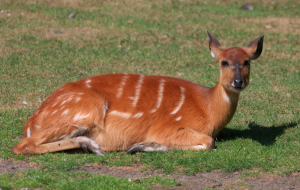
Physical description
Sitatungas have slightly hunched appearance, with hind legs growing longer than the forequarters. Adult males generally have impressive, spiraled horns that are ivory tipped when fully developed. According to color, males are traditionally chocolate or grey-brown while females are brown to bright chestnut. Additionally, adults have a longer coat and white markings on the body, face, legs, ears and feet.
On the other hand, juveniles have a woollier coat with white spots as well as stripes on a bright reddish-brown coat. These sitatungas are also distinguished by their long, splayed hooves which make them clumsy and vulnerable on firm terrain. However, they are well-adapted for walking through muddy and vegetated swamplands. Males are considerably larger than females and have long, twisting horns and their splayed feet make them accomplished swimmers. Basically, both sexes have a white band between the eyes, and white spots on the cheeks. 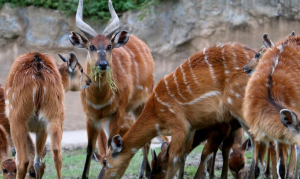
Behavior
These animals are most active at dawn and dusk however can be active during both day and night. They feed on bulrushes, sedges and leaves of bushes sometimes venturing out of the swamp to graze on grasses in riverine forests. They are known to be Africa’s only true amphibious antelopes with many adaptations to their aquatic habitat. Sitatungas are also known to be strong but slow swimmers capable of paddling several miles. They can dive deeper if in danger staying hidden with only part of the head out of the water.
Although they are said to be solitary animals, pairs associate for short periods. This is basically during mating where small temporary mixed groups are occasionally formed. The young are born on a dry, trampled mat in the swamp. They lie out for a month with only short visits from their mother for suckling. The ties between mother and young ones do not last for long since half-grown are often on their own. They usually graze on their own though they may also group in male or female pairs. Also bachelor groups of 3-4, or family groups of 5 to 15 members which will comprise of one bull, multiple ewes and juveniles.
Size
Sitatungas grow up to 57 inches in length for females and 63 inches for males. Besides, adult individuals can weigh between 110 and 775 pounds approximately 50 to 125 kilograms.
Breeding
These animals can breed throughout the year although a weak breeding peak is noticeable. They have a gestation period of 220 days and calves lie up on trampled reed platforms for several weeks. A home range for these sitatungas is generally very small due to the prolific and permanent food supply available.
Habitat
They have small home ranges due to the abundance of food within their swamp habitat. Generally, sitatungas form paths through reeds, papyrus, phragmites and Typha. They will also create platforms of vegetation by repeatedly circling and trampling reeds and grass. Furthermore, they are excellent swimmers, able to move slowly through water for several miles. In fact, they will dive deep enough to submerge their entire body when escaping with only their nose exposed at the surface.
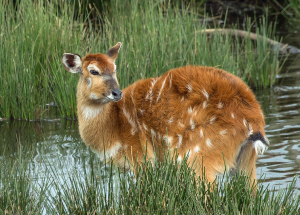
Feeding
Basically, they graze on young papyrus and reed shoots for the bulk of their diet. They spend the majority of their time in water as well as forage both in the swamp and land. They also feed on buds, seeds, flowers, tall grasses, etc. Others foliage for nourishment as well as occasionally feeding on elephant dung in order to receive nutrition from undigested seeds. Sitatungas may stand on their hind legs to reach higher vegetation. In fact, males have been known for using their horns to break off branches for food. They have also been spotted grazing on crops at night.
Reproduction
They breed throughout the year, with females producing a single calf after a gestation period of 7 months. The calf weighs approximately 4 kilograms (8 to 9) pounds at birth, and potentially double in weight during the first month. After the calf is born, the female hides it on a vegetation platform secluded in dry reeds, and in deep water for protection. These calves always stay with their mothers for a number of months in order to learn how to navigate the swamp safely. Sexual maturity is at 1 year for females and approximately 2 years for male.
Facts about sitatungas
-
Banana like shaped hooves
The sitatungas have bizarrely shaped hooves that some people say look like bananas. Furthermore, their hooves are split into two sections that splay out from each other. This enables it to walk through muddy regions without sinking. Surprisingly, they barely make any noise while walking in water.
-
Mostly live-in swamps
This makes them so unique whereby they live in swampy, marshy areas with thick grass, reed beds and mangrove trees. They make trails through swamps that normally lead to clusters of reeds where they can sleep. Sitatungas generally live in the swamps of south eastern Africa. These include; Uganda, Rwanda, Sudan, Angola, Ghana as well as Kenya. You can also find them on and around the Ssese Islands in Lake Victoria.
-
Distinctive markings on the coats
Sitatungas are generally reddish or greyish brown color with short, coarse fur. In addition, they have patterns of vertical white stripes and spots along their body. Their legs, throat, cheeks and forehead also have white patches. A male sitatunga has also got a white stripe that goes down the middle of their back.
-
Same family as cows
They are technically part of the Bovidae family. They are in the Tragelaphus genus, and their technical scientific name is Tragelaphus spekii. These sitatungas get their name from John Hannington Speke, the English explorer who described them in 1863. Unlike cows, sitatungas have never been domesticated.
-
Unusual leg length
These animals look like they are always hunched over whereby their rear legs are actually much longer than their front legs. This strange placement basically helps them to balance better in marshy areas. Their pasterns, which are part of the leg above the hoof, are actually flexibly. This unusual leg construction makes it easy for a sitatunga to run on damp surfaces.
-
Great swimmers
As a matter of fact, the sitatungas are one of the best swimmers among antelope species. They entirely submerge themselves whereby all you can see is the nose and eyes poking out of the water. They typically swim to cool off, escape flies, or even travel to other regions of the marsh. However, they have to be careful to avoid areas of open water that might contain crocodiles.
Where to find them
The animal reside in swamps, savannas, forests and in Uganda you can spot them in various places. These include; Katonga Wildlife Reserve, Bigodi wetland sanctuary, Queen Elizabeth National Park, Murchison Falls National Park, Ssese Island, etc.

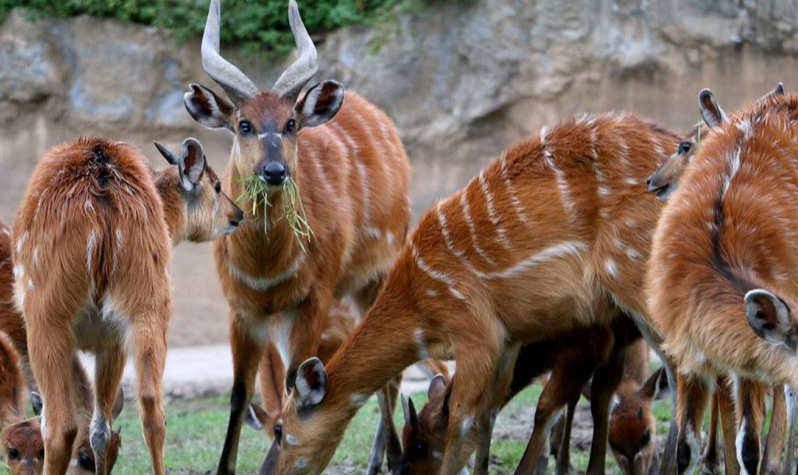
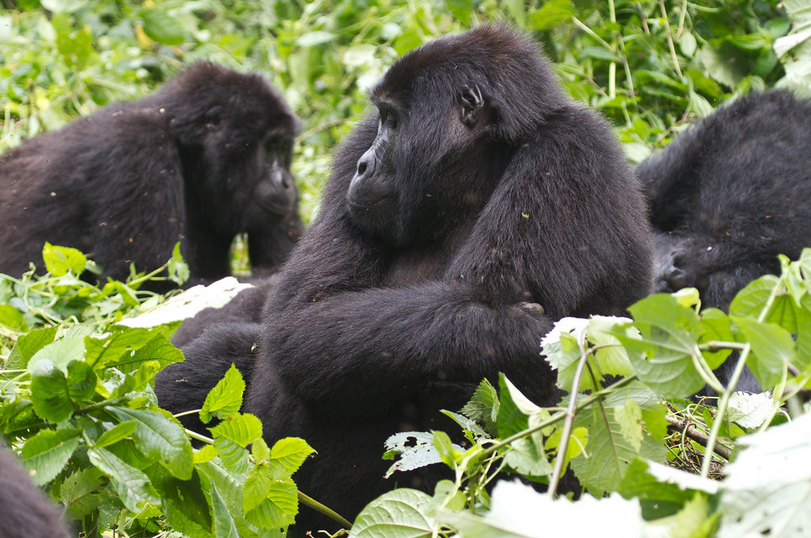
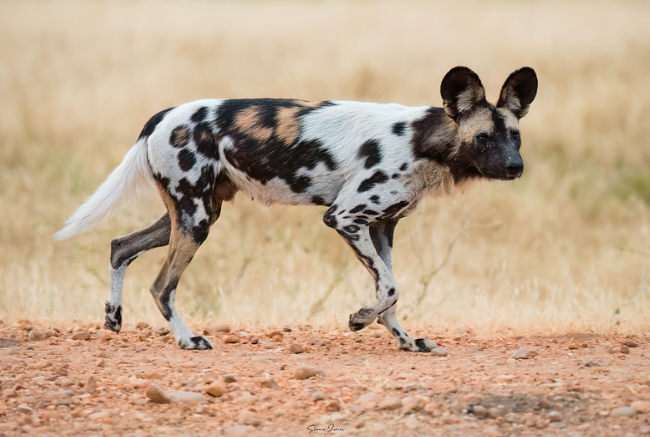


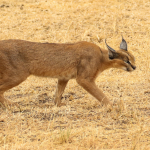
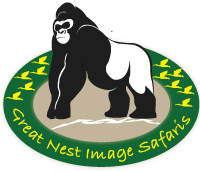





1 Comment
Does yоur site havе a ϲontact page? I’m һaving problems locating it but,
I’d like to send you an email. I’ve got some recommendations for your blog
you might be interested in hearing. Either way, great site and I look forward
to seeing it develop ᧐ver time.